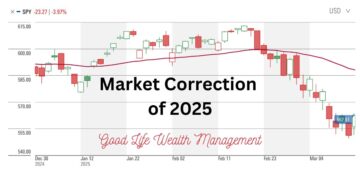In theory, Return and Risk are linked – you cannot get a higher rate of return on an asset allocation without taking more risk. However, portfolios can be inefficient and there are a number of ways we can improve your return without adding risk or changing your asset allocation. Here are five ways to increase your returns:
1. Lower Expense Ratios. Many mutual funds offer different “share classes” with different expense ratios. The holdings are the same, but if one share class has 0.25% more in expenses, those shareholders will under perform by 0.25% a year. Here at Good Life Wealth Management, we have access to Institutional shares which have the lowest expense ratio. Generally, these funds are available only to institutions or individuals who invest over $1 million. We can buy these shares for our investors, without a minimum, which frequently offer savings of 0.25% or more versus “retail” share classes.
2. Increase your Cash Returns. If you have a significant amount of cash in your holdings, make sure you are getting a competitive return. Many banks are still paying 0% or close to zero, when we could be making 1.5% to 2% elsewhere.
3. Buy Treasury Bills. If you have a bond mutual fund and it charges 0.60%, that expense reduces your yield. If the bonds they own yield 2.8%, subtracting the expense ratio leaves you with an estimated return of 2.2%. Today, we can get that level of yield by buying Treasury Bills, such as the 26-week or 1-year Bill, which have a short duration and no credit risk. If you are in a high expense bond fund, especially a AAA-rated fund, it may be preferable to own Treasury bonds directly and cut out the mutual fund expenses. We participate in Treasury auctions to buy bonds for our clients.
4. Buy an Index Fund. If you have a large-cap mutual fund, how has it done compared to the S&P 500 Index over the past 5 and 10 years? According to the S&P Index Versus Active report, for the 10-years ended December 2017, 89.51% of all large-cap funds did worse than the S&P 500 Index. Keep your same allocation, replace actively managed funds with index funds, and there’s a good chance you will come out ahead over the long term.
5. Reduce Taxes. Two funds may have identical returns, but one may have much higher capital gains distributions, producing higher taxes for its shareholders. If you’re investing in a taxable account, take some time to look at the “tax-adjusted return” listed in Morningstar, under the “tax” tab, and not just the gross returns. Even better: stick with Exchange Traded Funds (ETFs) which typically have much lower or even zero capital gains distributions. This is where an 8% return of one fund can be better than an 8% return of another fund! We prefer to hold ETFs until we can achieve long-term capital gains, and especially want to avoid funds that distribute short-term gains. We also look to harvest losses annually, when they occur, to offset gains elsewhere.
How can we help you with your investment portfolio? We’d welcome the chance to discuss our approach and see if we would be a good fit with your goals.







